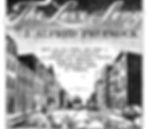Love and Isolation in “The Love Song of J. Alfred Prufrock”
- Carrianne Dillon
- Apr 2, 2020
- 4 min read

T. S. Eliot’s “The Love Song of J. Alfred Prufrock” is a strong example of Modernist writing. Exploring the themes of love and isolation, the poem explores the internal concerns present when trying to fall in love. Throughout the poem, Eliot depicts the struggles an individual might face in acting upon romantic feelings. We are given clear examples of insecurity and despair as Prufrock weighs the pros and cons of taking action. By the end of the poem we get the sense that Prufrock has come to terms with his anxieties, and has recognized that he was never going to be the Prince sweeping a woman off her feet.
Images that could be romantic are juxtaposed with those that have a more clinical or disturbed tone. The first few lines of the poem demonstrate this. Eliot opens with, “Let us go then, you and I,/ When the evening is spread out against the sky/ Like a patient etherized upon a table;”(Eliot, ln1-3). A sunset is a commonly romanticized event, considered a charming (and inexpensive) way to spend time with a partner. However, instead of envisioning the vibrant colors of a sunset, we’re given the image of an etherized patient. This does not seem like the most successful manner of romancing someone. Opening with this suggests that Prufrock is slightly awkward with courtship, and that he may have different ideas of beauty and reality than the average individual. The discordant visuals resonate with T. S. Eliot’s exploration of metaphysical imagism. This is in keeping with Modernism, as pairing the evening sky with an etherized patient breaks from the Romantic and Victorian ideals and use of imagery.
The world was at war when this poem was written and published, and to me it is apparent that Prufrock is waging a war within himself as he considers a course of action. On one hand Prufrock reassures himself, “There will be time, there will be time/ To prepare a face to meet the faces that you meet;/… Time for you and time for me,/ And time yet for a hundred indecisions,/ And for a hundred visions and revisions”(Eliot, lns26-33). Here he seems to excuse his dithering on the basis of the belief that he has enough time to collect his courage before taking the plunge with whomever he thinks he loves. On the other hand, Prufrock knows he will never actually follow through.
Later on in the poem, our poor Mr. Prufrock admits his cowardice. He says, “I am no prophet- and here’s no great matter;/ I have seen the moment of my greatness flicker,/ And I have seen the eternal Footman hold my coat, and snicker,/ And in short, I was afraid”(Eliot, lns83-85). In this passage we are clearly told what the crux of the issue is. Prufrock is afraid, which is an absurdly common and relatable problem to have when considering approaching someone you like. Provided with musings on “Arms that are braceleted and white and bare”(Eliot ln63) and a “…head (grown slightly bald)”(Eliot ln82), we understand that Prufrock has body image concerns. These perceived deficits combine with a fear of being taken apart word by word, a desperate insecurity about what others will think. Prufrock fears “The eyes that fix you in a formulated phrase,/And when I am formulated, sprawling on a pin, When I am pinned and wriggling on the wall,/ Then how should I begin”(Eliot lns56-59). These things hold him back, and prevent him from establishing any sense of intimacy with anyone. Prufrock spends so much time inside his own head, needling himself and berating himself that he fails to take concrete action.
By the end of the poem Prufrock comes to terms with how ridiculous his waffling has been. There is no drastic character development, but an acknowledgement of his good and bad qualities. Prufrock reflects, “I am not Prince Hamlet, nor was meant to be;/… Deferential, glad to be of use,/ Politic, cautious, and meticulous;/ Full of high sentence, but a bit obtuse;/ At times, indeed, almost ridiculous-/ Almost, at times, the Fool”(Eliot lns111-119). This somewhat rueful realization is as much of a breakthrough as we are privy to. Prufrock seems to come to terms with the fact that life did not cast him in the hunky, leading role, and acknowledges that there are some good things about his personality.
“The Love Song of J. Alfred Prufrock” explores themes of insecurity, isolation, unrequited love, despair, and social alienation. Prufrock’s inner turmoil is reflected throughout the poem, and T. S. Eliot does a remarkable job of making the struggles relatable and real. Many people experience the same consternation and hopelessness when contemplating initiating a romantic relationship. Well-crafted and teeming with Modernist themes, “The Love Song of J. Alfred Prufrock” guides readers through the issues that prevent interpersonal relationships. Eliot allows J. Alfred Prufrock to demonstrate how to learn about oneself in the context of a society desperate for connection.
Works Cited

